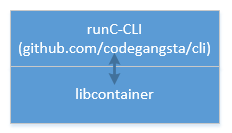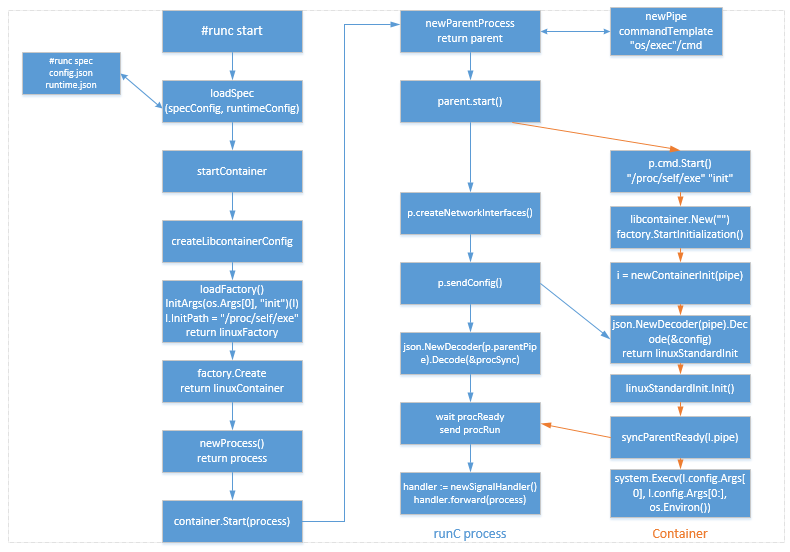runC作为开放容器标准组织推出的开源容器项目,该工具可以及其轻量级的创建container,通过便捷的命令行工具并对其管理和操作。从整体架构来看,其对平台依赖较小,整个project都使用了Golang进行了开发。
整体架构
runC的架构比较简单,从技术构成角度来看,主要是一个便捷的命令行工具+libcontainer。
CLI
runC的CLI是使用的github.com/codegangsta/cli, 该cli库也是Golang的第三方库,提供了一个易于使用的命令行接口。
1 | $greet help |
用户可自由添加CLI中所需的commands与options并提供对应的action function即可。1
2
3
4
5
6
7
8
9
10app.Commands = []cli.Command{
{
Name: "add",
Aliases: []string{"a"},
Usage: "add a task to the list",
Action: func(c *cli.Context) {
println("added task: ", c.Args().First())
},
},
...
具体API可参看github.com/codegangsta/cli的官方说明文档,这里主要分析libcontainer的实现。
libcontainer
libcontainer为container的创建提供了一种golang的实现,包括container的namespace,cgroups,capability,filesystem access controls. 可以由使用者自由管理container的生命周期,包括container的checkpoint和restore。
Container创建流程
1 runc start命令行执行函数首先会导入配置文件,配置文件即config.json和runtime.json.都为json格式,主要描述了运行container所需的系统配置。 配置文件可以由用户自定义或者使用#runc spec自动生成默认的配置。
2 在创建container前创建了Factory,Process,LinuxContainer等对象,这些对象主要是对container的运行环境进行了抽象的封装。
1 | // LinuxFactory implements the default factory interface for linux based systems. |
3 在loadFactory()中使用了InitArgs(os.Args[0],”init”)(l)来初始化container的执行入口。而l.InitPath = “/proc/self/exe”,即选择了自身的二进制作为进程创建的入口。
4 newParentProcess()创建了一个PIPE作为runc start进程与container内部init进程通信管道。同时创建一个commandTemplate作为ParentProcess运行的模板,commandTemplate使用的是GO package中的os/exec库,见https://golang.org/pkg/os/exec/,主要的结构为Cmd,封装了运行一个新的执行体所需要的各种环境。而namespace,filesystem及其它所需配置的运行环境信息都注册在了Cmd这个结构中。
1 | type Cmd struct { |
5 通过parent.start()调用cmd.start()创建了新的进程。而此时新的进程使用/proc/self/exec作为执行入口,参数为”init”.Go语言中的init函数比较特殊,其会在main函数调用之前调用,所以在新的进程中func init()会直接调用,而不会去执行main函数。
1 | func init() { |
6 init()会从之前创建的pipe里读取父进程同步过来的配置进行初始化,初始化完成后会sync一个Ready的状态到父进程,父进程收到后同步一个此时子进程已经是在容器环境中了,最后container会调用system.Exec()执行用户在json文件中配置的binary。
7 linuxStandardInit.init()是container内部进行初始化的主要函数,根据runc start进程发来的config进行初始化
1 | setupNetwork |
这样一个完整的container初始化完成并创建成功。后续我们再看libcontainer是如何对各个子模块进行初始化和配置的。


